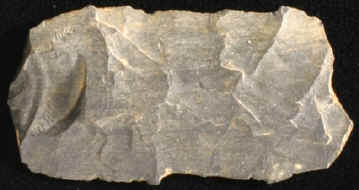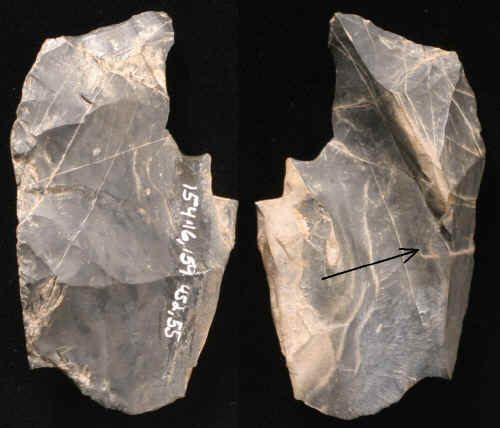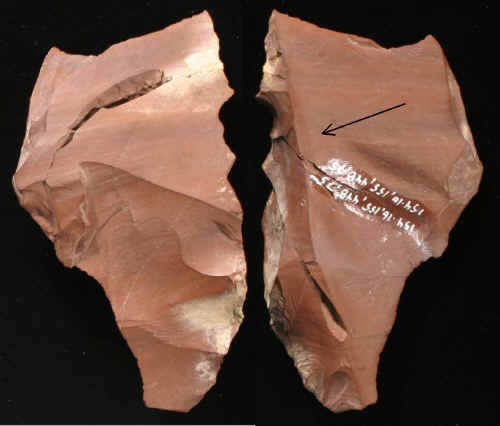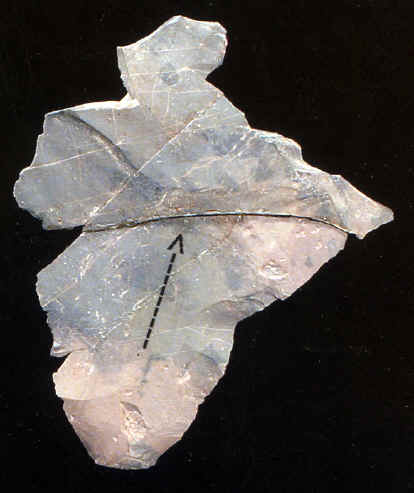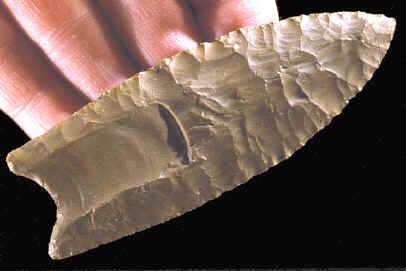|
|
|
A possible explanation for the de-emphasis of Clovis presence at Munsungan/Chase Lakes, it seems to me, is Robson Bonnichsen’s and colleagues’ disappointment about their failure to discover absolutely datable remains within the shallow, highly acidic soils of the north Maine woods. Although a possible Paleo-American hearth was noted at the Fluted Point Site (154-14), no pertinent dates were obtained. The Windy City site had patterned distributions of lithic debitage but no hearths with charcoal. Lacking useful dates, cultural ascription was abandoned in favor of using more generalized concepts such as "Paleo-Indian Pattern" (Bonnichsen et al. 1991: 23). The question of Clovis presence went begging. |
|
|
Windy City Artifacts According to Bonnichsen and his student Payne, within the estimated 50-60% of the Windy City site that was explored, at least 14 "lithic events" had taken place; as many as 35 biface and 5-core reduction sequences were present. A noteworthy lithic event was the failed manufacture of a late-stage Clovis perform (Figure 2) – perhaps marking an attempt to replace the discarded basal fragment of a finished Clovis point unearthed nearby (Figure 3)? Additional fragmentary channel flakes resulting from final episodes of fluting were also recovered at Windy City (Figure 4). |
|
|
Pertinent to our argument that the occupants of Windy City represented the Clovis archaeological culture is a restored early stage biface of Munsungan chert with an indisputable overshot flake (Figure 5). In addition, Robson Bonnichsen and his excavators recovered actual overshot flakes belonging to bifaces perhaps removed anciently from the workshop (Figures 6A and 6B). Another expanding overshot flake struck off a biface by a Clovis knapper is shown in Figure 7. This specimen was restored by James Payne from fragments found separately. By what means these distinctive flakes were removed from the parent biface is a matter for conjecture. However, recent replicative studies by knapper Mike Dothager of Vandalia, Illinois, suggest that indirect percussion using the ground surface as a working platform may have been a means (Dothager and Pete Bostrom, personal communications). |
|
|
|
|
Making cores from quarry blocks of Munsungan chert was a subsidiary activity at Windy City. The cores themselves appear to have been taken away by the site’s occupants. A remarkable feat of refitting debitage has given us a "spiderwork" of connected flakes surrounding a vacant space (see Payne 1985). The shape of the space suggests an elongate block – likely a core capable of generating flake-blades or prismatic blades. Prismatic blades themselves, fresh or exhausted- fragmentary or complete, were not unearthed at the Windy City workshop – a fact not altogether surprising in light of the site’s small size and short life span. Cores produced at Windy City and the Clovis unifacial tools made on flake-blades and prismatic blades struck off them would have come to rest on sites elsewhere that were visited by ranging bands of hunters. A similar situation is argued by Collins (1999) to explain caches of prismatic blades cores and blades on the High Plains. |
|
|
|
|
In Sum In all northeastern North America east of Ohio and north of Pennsylvania only a few quarry-and-workshop complexes utilized by Paleo-Americans have been reported upon by trained archaeologists since the inception of Paleo-American studies. The two best-known site complexes of this type are West Athens Hill, New York and Munsungan. The first of these (Funk 1973, 2004) was explored as early as 1962 and its assemblage was not inspected for residues of "lithic events" as was later done at Windy City by Bonnichsen, Payne and colleagues. In setting the analytical "bar" for recognition of Clovis culture so high, Collins and Kay necessarily (and rightly) have excluded the Paleo-American workshops at West Athens Hill from consideration. In the case of the Windy City site at Munsungan/Chase Lakes, Piscataquis County, northern Maine, however, we argue that our candidate has cleared the bar with room to spare. Acknowledgements I wish to thank Dr. Bruce Bourque of the Maine State Museum for encouraging my interest in Robson Bonnichsen’s collections, files, and other data relating to his Munsungan Project and for providing photographs of the Windy City artifacts, etc. To the more than 20 crew members who worked at Windy City, to analyst James Payne, and to Rob Bonnichsen’s scientific associates (Brad Lepper, Victor Konrad, Vickie Clay and Karen Turnmire) I offer apologies for assuming a role that is more rightfully theirs. |
|
|
"REFERENCES" Bonnichsen, Robson, George L.
Jacobson, Jr., Ronald B. Davis, and Harold W. Borns, Jr. Bonnichsen, Robson, David Keenlyside, and Karen Turnmire Collins, Michael B. (and Marvin Kay) Funk, Robert E. Patterns in the Northeast," New
York State Museum and Science Service Memoir 20. Albany. Gramly, Richard Michael Haynes, C. Vance Konrad, Victor A., Robson Bonnichsen, and Vickie Clay Payne, James Pollock, Stephen G., Nathan D. Hamilton and Robson Bonnichsen Warnica, James M. Richard Michael Gramly
|
|
